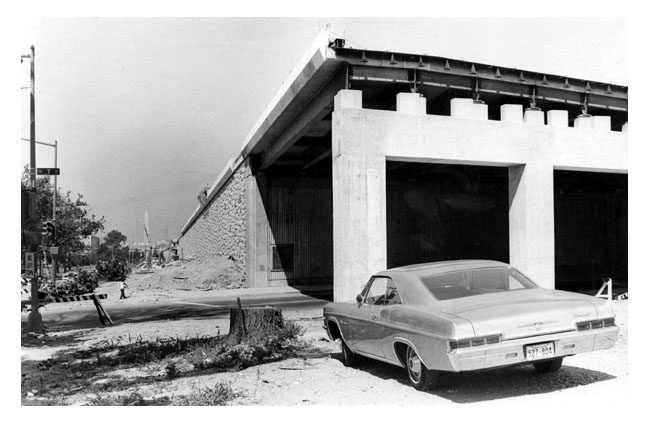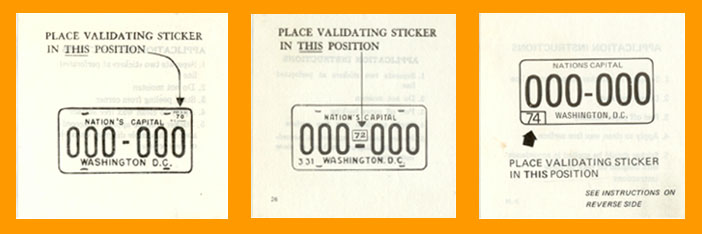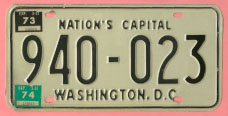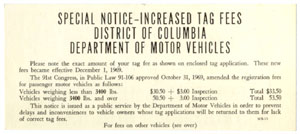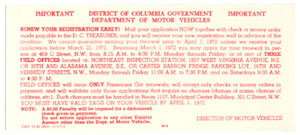1968 Baseplate
General-Issue Passenger Car Plates Used April 1968 Through March 1974
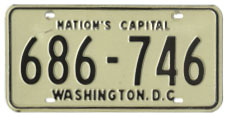 |
 |
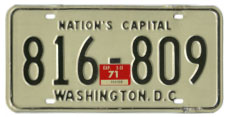 |
1968 (exp. 3-31-1969) |
1969 (exp. 3-31-1970) |
1970 (exp. 3-31-1971) |
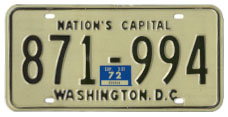 |
 |
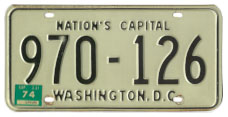 |
1971 (exp. 3-31-1972) |
1972 (exp. 3-31- 1973) |
1973 (exp. 3-31-1974) |
Just the Facts... |
|
Construction |
6" x 12", aluminum or steel covered with reflective white sheeting. Issued in pairs. |
Design |
Plain, all-embossed black on white. No graphics. |
Period of issuance |
Six years: April 1, 1968, through March 31, 1974. |
Period of use |
Only during the period specified above. |
Other facts |
An April 1 through March 31 registration year was used during the life of this base. |
Plates of this base were assigned sequentially from number 500-000 (or possibly 500-001) through 999-999, at which time (probably during February and March of 1974) a small number of plates in the 400-000 series were issued until the 1974 base was introduced. For their first registration year, these plain, undated plates were used with no visible indication of the registration year or validation. Reflective stickers were issued to validate 1968 baseplates, and with respect to plates distributed in conjunction with the issuance of a new registration (as opposed to a renewal transaction), the final three digits in the sticker serial number should match the final three digits on the plate. This concept is described in general at the Validation Stickers page, and specifically relative to the 1968 baseplate below.
Although most plates of this base are aluminum, those with the highest numbers are steel. The highest documented aluminum plate is number 957-853, and the lowest observed steel plate is 970-126. Both are natural 1974 issues. Whether 400-000 series plates are steel or aluminum is unknown.
Production and Distribution of 1968 Baseplates
It was in mid-February 1968, when the new baseplate was unveiled, that Washingtonians were introduced to the concept of aluminum license plates intended to be used for more than one or two years. DMV director William Heath announced on Feb. 15 that the new plates cost his agency $1.11 per pair and that they were expected to be used for "four or five years," revalidated annually with validation stickers that cost "only 10 or 15 cents." The increased cost over traditional steel plates, which were then only $.53 per set, was offset by the savings realized by not having to purchase and distribute new plates every year or two.
New plates assigned to motorists that by early February had already applied for their 1968 registrations were mailed beginning on Fri., Feb. 16. Beginning March 1, those who had not applied by mail could renew their registrations and get their new plates by appearing at the DMV's downtown office at 469 C St. NW, or at either of two temporary offices set up just to address the renewal work. One was at the vehicle inspection station at 1827 West Virginia Ave. NE, and the other was operated from a trailer parked at 30th St. and Alabama Ave. SE. The temporary offices only issued passenger car plates and accepted only checks or money orders in payment but they were open until 7:30 p.m. on weeknights and from 9:00 a.m. to 4:30 p.m. on Saturdays whereas the permanent DMV office was not. They therefore presumably did a brisk business, especially as the Sun., March 31 renewal deadline approached. By the end of March, 182,606 pairs of 1968 plates had been sold compared to 175,904 renewal transactions processed the year before.
Later in 1968 DMV officials apparently proposed to the city council that new plates continue to be issued annually instead of renewing the 1968 baseplates for multiple years as had been the original plan. A Feb. 1969 Washington Post article about the issuance of dated "EXP. 3-31-70" stickers for the 1969 registration year indicates, however, that the DMV had been rebuffed when it tried to convince councilors that continuing to change the color of license plates every year made sense because it would, among other benefits, make them "more readily identifiable to law enforcement officers." They unsuccessfully suggested that switching back to steel plates and issuing them singly, not in pairs, would be a cost-effective solution for the future. Although dated annual plates made of steel were in fact reintroduced in 1969 for several non-passenger plate types, general-issue auto plates were revalidated with stickers for the 1969 registration year as well as four additional years thereafter. Black-on-yellow 1969 stickers went on sale at the Municipal Center at 300 Indiana Ave. NW on Feb. 24, and a week later at the same locations at which plates were sold a year earlier plus an additional temporary office at 16th and Kennedy Streets NW.
1968-73 Registration Numbers
As discussed below and with minor exceptions as indicated, certain blocks of registration numbers were used only for new general-issue passenger registrations during the six registration years during which this base was issued. It appears that about 60,000 new registrations were issued annually during this period. The lowest numbers on the 1968 base, 500-000 (or 500-001) through about 655-000, are thought to have been available exclusively to replace valid 1966 baseplates during March 1968. Higher-numbered 1968 general-issue auto plates were issued during registration years specified in this table:
Reg. Year |
Twelve-Month Period of Use |
Sticker Marked |
General-Issue Registration Numbers |
Quantity of Available New Numbers |
1968 |
4/1/68-3/31/69 |
(n/a) |
c.655-000 to 710-999 |
56,000 |
1969 |
4/1/69-3/31/70 |
"70" |
711-000 to 769-999 |
59,000 |
1970 |
4/1/70-3/31/71 |
"71" |
770-000 to 819-299 |
49,300 |
1971 |
4/1/71-3/31/72 |
"72" |
819-300 to 877-999 |
58,700 |
1972 |
4/1/72-3/31/73 |
"73" |
878-000 to c.939-999 |
62,000 |
1973 |
4/1/73-3/31/74 |
"74" |
945-000 to 999-999, then |
55,000 |
c.940-000 to 944-999, then |
5,000 |
|||
low 400-000 series nos. |
The Unusual Sticker Placement Pattern of the 1968 Base
Stickers applied to 1968 baseplates for the 1969 through 1973 registration years are as follows:
Reg. Year |
Twelve-Month Period of Use |
Sticker Marked |
Colors |
Proper Location |
1969 |
4/1/69-3/31/70 |
EXP. 3-31-70 |
black on yellow |
upper right corner |
1970 |
4/1/70-3/31/71 |
EXP. 3-31-71 |
white on red |
center, below dash |
1971 |
4/1/71-3/31/72 |
EXP. 3-31-72 |
white on blue |
center, above or below dash* |
1972 |
4/1/72-3/31/73 |
EXP. 3-31-73 |
white on black |
upper left corner |
1973 |
4/1/73-3/31/74 |
EXP. 3-31-74 |
white on green |
lower left corner |
| * As discussed below, the 1971 ("72") sticker should be placed above the dash on plates renewed during the previous registration year, and below the dash on natural 1971 plates. | ||||
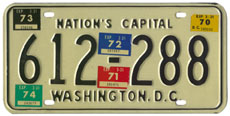 The unusual pattern in which validation stickers were properly placed on this base warrants separate consideration. Sticker location sites are illustrated here with plate no. 612-288, and listed in the table above. One of the more interesting topics relative to the 1968 baseplate, and D.C. multi-year baseplates in general, is the proper location of 1970 (red, dated “71”) and 1971 (blue, dated “72”) stickers. They belong in the middle of the plate, not in any of the corners. The default location for stickers of both years is below the dash, although on plates with both stickers the red sticker goes below and the blue one above, which is to say that the later sticker should not cover the earlier one.
The unusual pattern in which validation stickers were properly placed on this base warrants separate consideration. Sticker location sites are illustrated here with plate no. 612-288, and listed in the table above. One of the more interesting topics relative to the 1968 baseplate, and D.C. multi-year baseplates in general, is the proper location of 1970 (red, dated “71”) and 1971 (blue, dated “72”) stickers. They belong in the middle of the plate, not in any of the corners. The default location for stickers of both years is below the dash, although on plates with both stickers the red sticker goes below and the blue one above, which is to say that the later sticker should not cover the earlier one.
 The first of the two, the red 1970 (“71”) sticker, should properly appear below the dash, and our experience has been that this is practically always the case. If the plate is a natural (such as no. 816-809), one issued for a new registration during the April 1970-March 1971 registration year, there should be no 1969 (yellow, dated “70”) sticker in the upper right corner, and the final three digits in the serial number of the red sticker should match the final three digits on the plate. (More about this last point here.) If the plate is not a natural, but rather an older (1968 or 1969) registration that was renewed for the 1970 registration year, the red sticker should still be below the dash but the last three digits of the sticker serial and plate number will not match.
The first of the two, the red 1970 (“71”) sticker, should properly appear below the dash, and our experience has been that this is practically always the case. If the plate is a natural (such as no. 816-809), one issued for a new registration during the April 1970-March 1971 registration year, there should be no 1969 (yellow, dated “70”) sticker in the upper right corner, and the final three digits in the serial number of the red sticker should match the final three digits on the plate. (More about this last point here.) If the plate is not a natural, but rather an older (1968 or 1969) registration that was renewed for the 1970 registration year, the red sticker should still be below the dash but the last three digits of the sticker serial and plate number will not match.
 The blue 1971 (“72”) sticker may be found above or below the dash depending on whether the plate is a renewal (no. 612-288 shown above is an example) or natural (such as no. 871-994). Many collectors have incorrectly assumed that all blue stickers should be placed above the dash because that's where it is seen on renewed plates (which includes most plates owned by collectors today). To corroborate this, shown below are sticker placement instructions provided to motorists to whom stickers were provided (by mail or at a DMV office) as they renewed their registrations in early 1971. In these cases it is clear that above the dash is the proper site for the blue sticker on plates being renewed, which is to say those upon which the sticker was not affixed by the DMV.
The blue 1971 (“72”) sticker may be found above or below the dash depending on whether the plate is a renewal (no. 612-288 shown above is an example) or natural (such as no. 871-994). Many collectors have incorrectly assumed that all blue stickers should be placed above the dash because that's where it is seen on renewed plates (which includes most plates owned by collectors today). To corroborate this, shown below are sticker placement instructions provided to motorists to whom stickers were provided (by mail or at a DMV office) as they renewed their registrations in early 1971. In these cases it is clear that above the dash is the proper site for the blue sticker on plates being renewed, which is to say those upon which the sticker was not affixed by the DMV.
On natural plates, however, those first issued during the 1971-72 registration year, in most cases the sticker was placed (presumably by the DMV before issuance) below the dash. The final three digits of the sticker serial should match the final three numbers on the plate. This sticker location is also used on sample plates, corroborating our assertion that it is the correct display site for natural plates even though the blue sticker will be correctly placed above the dash if there is already a red sticker below it.
|
Information about the proper location of plate validation stickers issued in conjunction with registration renewals was provided to motorists with little slips of paper included in envelopes in which the stickers themselves were mailed. From left Sticker placement instruction slips for 1969 (marked "EXP. 3-31-70"), 1971 ("EXP. 3-31-72") and 1973 ("EXP. 3-31-74) stickers. |
Correlation of 1968-73 General-Issue Registration Numbers to Sticker Serial Numbers
With respect to plates distributed in conjunction with the issuance of a new registration (as opposed to a renewal transaction), the final three digits in the sticker serial number should match the final three digits on the plate. In order to understand the discussion that follows, an understanding of the concept of a "natural" registration (and license plate) is required. Those unfamiliar with this term should consult the glossary as well as our page about validation stickers, upon the latter of which the subject is addressed in detail.
For the 1969 through 1973 registration years, the years for which validation stickers were used on 1968 baseplates, it appears that sticker serial numbers began at 100000 each year and that stickers with the lowest serials were, at least initially, applied to the lowest-numbered passenger plates issued for new registrations. However, not for any of these years was a single batch of sequentially-numbered stickers used to validate all 60,000 or so general-issue passenger plates used for new registrations.
|
Some natural 1972 plates (first validated with a 3-31-73 sticker with a proper matching serial number) are known that have a 3-31-74 sticker that also has a matching serial number. This was caused by the preparation of too many natural 1972 plates. Because the supply outlasted the 1972 registration year, these leftover plates were stickered again (at Lorton or the DMV) for the 1973 registration year, and matching stickers were again properly used. Therefore, as discussed in detail below, these are properly considered natural 1973 plates even though they have two stickers! |
1968 Registration Year (April 1968-March 1969) It is difficult to identify which registration numbers were assigned for new registrations (i.e. on natural 1968 plates) during the first year of issuance of this base because stickers were not issued to validate them. We assume that the highest-numbered plates before the lowest natural 1969 number, which we believe to be 711-000, were issued for new registrations during the 1968 registration year. Because about 60,000 plates are known to have been set aside for new registrations in 1969 through 1973, we believe that any plate numbered 655-000 through 710-999 to which a "70" validation sticker was never affixed could reasonably be considered a natural 1968 plate.
1969 Registration Year (April 1969-March 1970) Natural license plates for this registration year are identifiable by the presence of a 1969 (marked "70") validation sticker with a serial number that corresponds to the registration number. Three plate-number-to-sticker-serial intervals have been identified for this year. Here are some examples:
License Plate Number |
1969 ("70") Sticker Serial No. |
Interval |
714-862 |
103862 |
611,000 |
726-216 |
119216 |
607,000 |
733-972 |
296972 |
437,000 |
739-238 |
302238 |
437,000 |
745-063 |
308063 |
437,000 |
The lowest and highest plate numbers in the table above are the lowest and highest natural registration numbers observed for 1969. We believe that dated "70" stickers were applied to plates beginning at serial number 100000, which leads us to conclude that the first natural 1969 plate was number 711-000. Further information about 1969 stickers is provided here.
1970 Registration Year (April 1970-March 1971) Natural license plates for this registration year are identifiable by the presence of a 1970 (marked "71") validation sticker with a serial number that corresponds to the registration number. Three plate-number-to-sticker-serial intervals have been identified for this year. Here are some examples:
License Plate Number |
1970 ("71") Sticker Serial No. |
Interval |
779-105 |
109105 |
670,000 |
781-202 |
111202 |
670,000 |
787-764 |
120764 |
667,000 |
816-809 |
324309 |
492,500 |
The lowest and highest plate numbers in the table above are the lowest and highest natural registration numbers observed for 1970. We believe that dated "71" stickers were applied to plates beginning at serial number 100000, which leads us to conclude that the first natural 1970 plate was number 770-000. Further information about 1970 stickers is provided here.
1971 Registration Year (April 1971-March 1972) Natural license plates for this registration year are identifiable by the presence of a 1971 (marked "72") validation sticker with a serial number that corresponds to the registration number. Three plate-number-to-sticker-serial intervals have been identified for this year. Here are some examples:
License Plate Number |
1971 ("72") Sticker Serial No. |
Interval |
819-546 |
100246 |
719,300 |
830-571 |
111271 |
719,300 |
847-626 |
300526 |
547,100 |
865-577 |
320577 |
545,000 |
871-994 |
326994 |
545,000 |
The lowest and highest plate numbers in the table above are the lowest and highest natural registration numbers observed for 1971. We believe that dated "72" stickers were applied to plates beginning at serial number 100000, which leads us to conclude that the first natural 1971 plate was number 819-300. Further information about 1971 stickers is provided here.
1972 Registration Year (April 1972-March 1973) Natural license plates for this registration year are identifiable by the presence of a 1972 (marked "73") validation sticker with a serial number that corresponds to the registration number. Two plate-number-to-sticker-serial intervals have been identified for this year. Here are some examples:
License Plate Number |
1972 ("73") Sticker Serial No. |
Interval |
882-759 |
104759 |
778,000 |
895-369 |
117369 |
778,000 |
904-674 |
126674 |
778,000 |
925-202 |
321202 |
604,000 |
940-537 |
336537 |
604,000 |
The lowest and highest plate numbers in the table above are the lowest and highest natural registration numbers observed for 1972. We believe that dated "73" stickers were applied to plates beginning at serial number 100000, which leads us to conclude that the first natural 1972 plate was number 878-000. Further information about 1972 stickers is provided here.
Although in conjunction with the manufacturing process a "73" sticker was applied to the plate with the highest number listed in the table above, this plate and others numbered above 940-000 (and perhaps a few slightly below) were not needed during the 1972 registration year. Therefore, when number 999-999 was reached during the 1973 registration year these leftover 1972 plates were updated with a "74" sticker, also with a matching serial number (as indicated in the 1973 section immediately below), and were issued for new 1973 registrations.
1973 Registration Year (April 1973-March 1974) Natural license plates for this registration year are identifiable by the presence of a 1973 (marked "74") validation sticker with a serial number that corresponds to the registration number.
First Batch of Natural 1973 Numbers One plate-number-to-sticker-serial interval has been identified for the original allotment of numbers for this year, 945-000 through 999-999. Here are some examples:
License Plate Number |
1973 ("74") Sticker Serial No. |
Interval |
951-640 |
106640 |
845,000 |
965-111 |
120111 |
845,000 |
990-633 |
145633 |
845,000 |
The lowest and highest plate numbers in the table above are the lowest and highest natural registration numbers from the first batch of 1973 plates, although we believe that numbers were assigned through 999-999. We believe that dated "74" stickers were applied to plates beginning at serial number 100000, which leads us to conclude that the first natural 1973 plate was number 945-000.
Second Batch of Natural 1973 Numbers Upon the issuance of registration number 999-999 sometime during the 1973 registration year (presumably late in the year, i.e. in early calendar year 1974), leftover 1972 registration year numbers were issued. We have numbers 940-023 (pictured above) and 940-537 in our collection, and both have stickers of both 1972 ("73") and 1973 ("74") with matching serial numbers. It's possible that numbers below 940-000 were also leftover from 1972 and reissued in 1973. Both of our 940,000 series plates have "74" stickers with a serial number that is 770,000 lower than the plate number.
Third Batch of Natural 1973 Numbers When the supply of leftover 1972 plates was depleted and additional registration numbers were needed to get through the 1973 registration year and until the new 1974 baseplates could be used, a relatively small quantity of plates in the 400-000 series, presumably beginning at the number, were made and issued. The 400-000 series was used for these overflow registration numbers because it was the only 100,000 block of six-digit numbers not already used on the 1966 or 1968 bases.
Further information about 1973 stickers is provided here.
|
This page last updated on December 31, 2017 |
 |
|
copyright 2006-2018 Eastern Seaboard Press Information and images on this Web site may not be copied or reproduced in any manner without consent of the owner. For information, send an e-mail to admin@DCplates.net |














